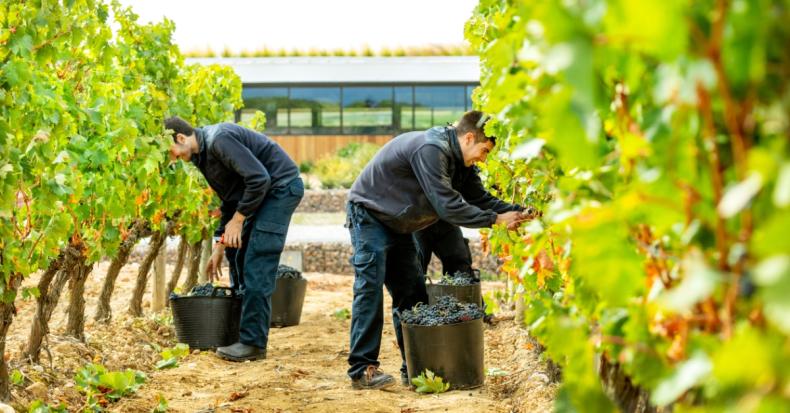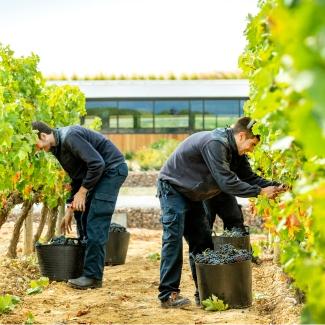Wine has been made in Rioja for over two thousand years. Over the centuries techniques have evolved and improved elevating the quality of the wines to new heights and making Rioja one of the most beloved wines in the world. In this section of our guide, we’ll tell you a little about winemaking in Rioja and how Rioja wine is made.
How is Rioja wine made?
For all the innovation that has taken place in Rioja – particularly when it comes to making wine sustainably – the basic method has remained largely unchanged. Grapes are harvested and, in some wineries, as at Beronia for example, they can be given a ‘cold maceration’, that is crushing the red grapes and keeping them at a low temperature for a period of time, prior to the start of fermentation.
When judged to be ready the grapes are ‘inoculated’ (dosed) with yeast, loaded into fermentation tanks where the yeast consumes some of the sugars and turns them into alcohol. This alcoholic fermentation can take anywhere from twenty to thirty-plus days depending on the vintage and the winemaker’s aims.
In the case of red wines – and for some whites – the must (juice) is pumped over the skins so they can impart colour, flavour, and add tannins – the complex compounds found in the skins help Rioja to age. Once fermentation has been completed, some wineries remove the grapes and give them a gentle pressing, which can add 15% to the production.
For white Rioja, the process is similar, but different in some key respects. Generally, the grapes are pressed after being picked and the juice, not bunches of grapes, is inoculated with yeast.
Rosé Rioja is either made by adding a little red wine to white wine, or by allowing the red grape skins to ‘bleed’ their colour into the juice.
Once the alcoholic fermentation has been completed, red Rioja wines undergo secondary fermentation, ‘malolactic fermentation’. This is a bacterial process that sees the bacteria Oenococcus oeni consume the harsher-tasting malic acid turning it into softer, creamier lactic acid. The process is used in some white wines, but not all.
Now the wine is ready, and it’s just a case of preparing them for ageing. The wines of Rioja have strict rules surrounding ageing – see the Rioja classifications blog – which extend to the type of oak and the length of time they must rest in barrel and bottle before being released.
Once they have received the required ageing, Rioja wines are usually blended. Blending may involve bringing together different grape varieties, wines from different vineyards, or even wines from Rioja’s three sub-regions. Blending allows winemakers to make the most out of that year’s harvest while maintaining the producer's style. Beronia’s style, for example, is for wines that are generously flavoured, traditional and capable of long ageing, wines that reflect the unique character of the vineyards from which they were produced.
What are the grape varieties used in Rioja?
While Rioja’s regulatory body, the Consejo Regulador Denominación Origen Calificada Rioja allows for some ‘experimental’ vines such as Cabernet Sauvignon, the main ones are as follows:
Red Rioja grapes:
Tempranillo
Pronounced as temp-rah-nee-ho, Tempranillo is Spain’s greatest black grape and is at the heart of most of Rioja’s finest wines. Typically, it gives deeply coloured, richly flavoured reds that are dominated by notes of blackberries, cherries, orange zest, spices, and dill. Tempranillo-based wines often drink well young but can age for decades.
Garnacha
Pronounced as gar-natch-ha, Garnacha is a thin-skinned, relatively low-coloured, low-acidity black grape that partners perfectly with Tempranillo. Garnacha wines are dominated by red cherries, strawberries, and cranberries and often have a gentle spiciness and a luscious mouthfeel.
Mazuelo
Pronounced as math-wey-lo, Mazuelo is a fruity, peppery black grape that’s often used to add power and complexity to blends. Mazuelo often tastes of blackberries, black figs, and blackcurrants with a distinct note of black pepper.
Graciano
Pronounced as grass-e-arno, Graciano is a thick-skinned grape that gives wines that are fresh-tasting, deeply coloured, and capable of ageing beautifully. While red-berry fruits tend to dominate, these are invariably supported by black fruit tones such as blackcurrant, blueberry, bramble, and black figs, with touches of spices and green herbs.
White Rioja grapes:
Viura
Pronounced as veera, and known as Macabeo, Viura is a fresh-tasting white grape with a floral, citrusy aroma. Its wines often taste of lemon and limes, green pears, honeydew melon and green herbs. This has to make up at least 51% of a white Rioja’s final blend.
Verdejo
Pronounced as ver-deck-ho, is one of Spain’s greatest white grape varieties. Fresh, zesty, and clean, its whites tend to taste of citrus fruits with a twist of aniseed and green herbs. Our Beronia Verdejo is made in our sister winery in Rueda rather than in Rioja.
Organic winemaking in Rioja
As part of the drive for sustainable winemaking in Rioja, organic Rioja is now available. Organic wine production is an emerging trend in Rioja which is environmentally friendly as it relies on working with nature to produce healthy grapes. This can involve practices such as using natural pest control – ‘bug eat bug’ as it’s sometimes known – planting cover crops between vines and using the 20 EU-authorised organic pesticides.
Organic winemaking isn’t easy, but if Rioja is to have a sustainable future, then this is one of the ways it can be achieved. The wines can also be spectacular. Beronia’s Organic Tempranillo has won a clutch of awards and offers a purity and depth of flavour that is a delight.
Enjoyed reading this blog? Find more interesting and educational blogs here.




